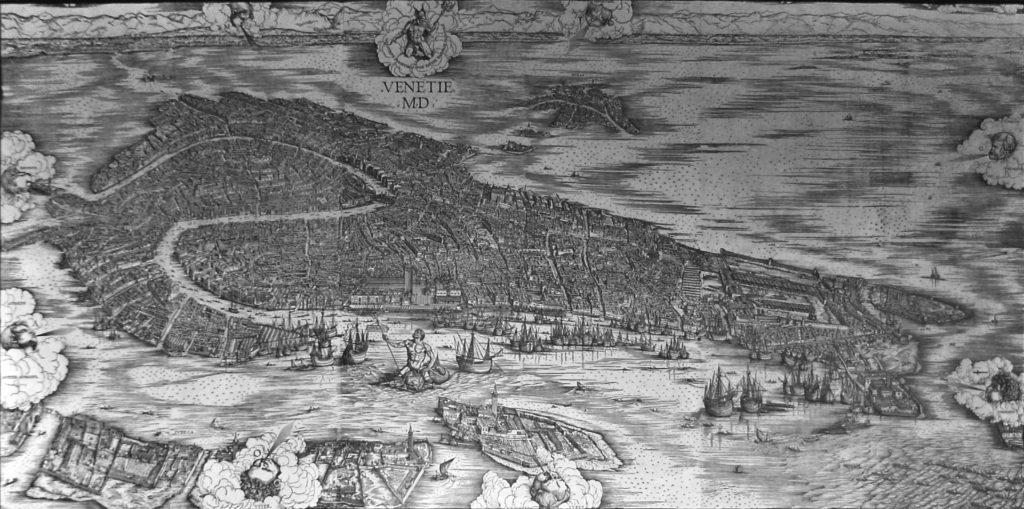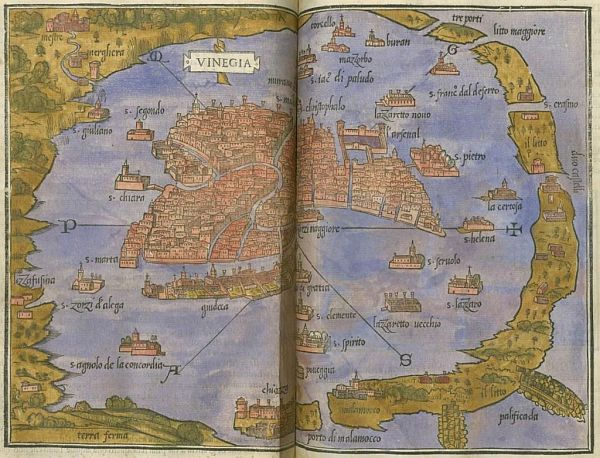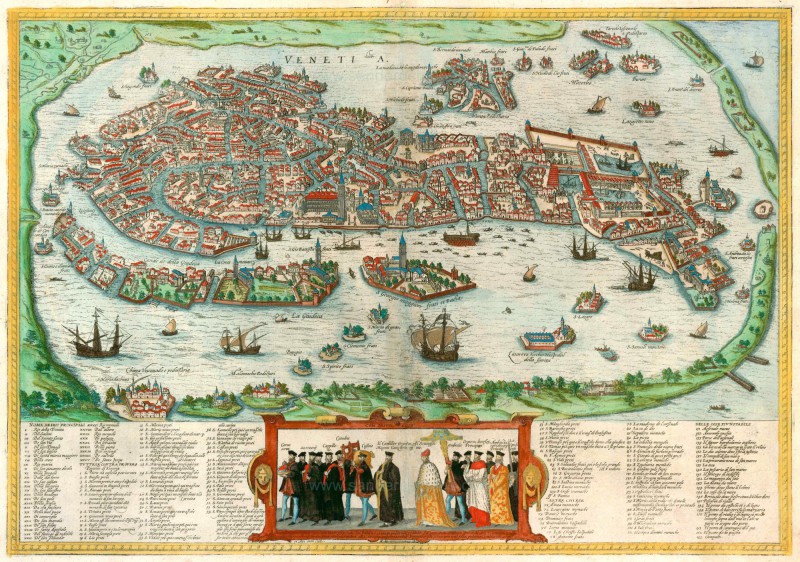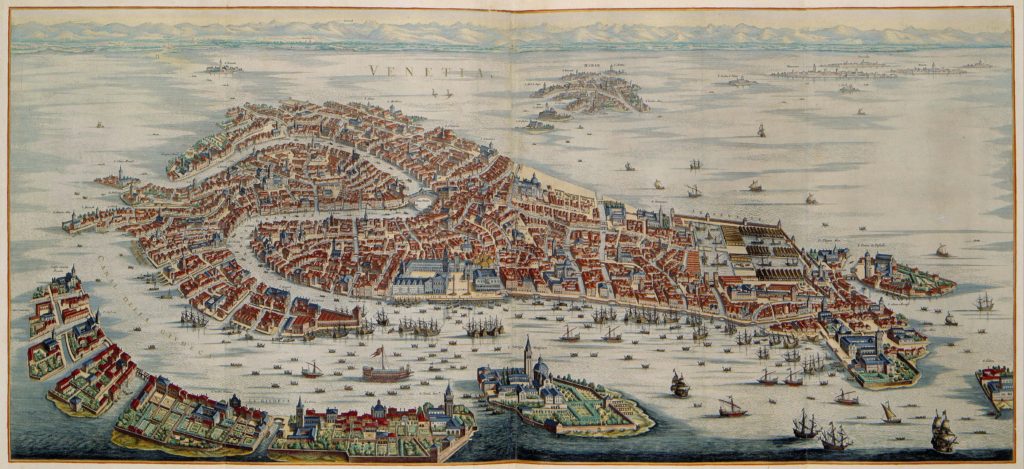
Reader Christopher has written the following Comment: I am perplexed and maybe you can help me. The Chiesa di Sant’Elena was built in as early as 1060 by some accounts. Saint Helen was brought to the lagoon and interred in her eponymous church in 1211. It’s curious that the church is not shown on the earlier maps. Any idea why this might be? ….
If I understand your question to be why isn’t the church dedicated to Sant’ Elena shown on maps prior to the arrival of her remains, I can only reply that I think there could be several reasons.
One reason is that there aren’t many maps of Venice prior to 1211, and those that do exist are not very detailed. Even 17th-century maps don’t show everything. Also, Venice has plenty of churches named for saints whose remains are not in residence. There’s no reason why a mapmaker with limited space would choose to show a church if it didn’t contain its tutelary saint. Which raises the interesting question, which I had never considered till now, as to who decides what to include in a map and what to leave out.
As to the dates you mention, “…the first chapel dedicated to St. Helen was built in 1028 and entrusted to the Augustinian order, which constructed also a convent. In 1211 the Augustinian monk Aicardo brought to Venice from Constantinople the presumed body of the empress. Following which the Augustinians enclosed the chapel within a larger church.” More confusion arises from the statement that there was a “hospital” dedicated to her, built in 1175 — 36 years before the saint arrived — maintained by the Augustinian order, for the care of the poor.
In the 15th century the convent and the church passed to the Benedictine monks, who rebuilt it in 1439. A century later, in 1515, the church was consecrated by the bishop of Aleppo and became an important religious center, with vast property and notable works of art. So evidently three centuries, all told, had to pass before her church (or let’s just say “she”) became sufficiently important to warrant identified inclusion on a map.
These sources don’t identify where the church was located, but I’m going to suppose it was on the island of Sant’ Elena.
Some maps, from the 1400’s onward, show at least part of an island floating off the eastern shore of Castello, just below Olivolo, where the church of San Pietro di Castello stands. So something was there, even if it isn’t identified. Yet if her eponymous original church was there, it does seem strange that so many cartographers didn’t show it, or if they did, why they didn’t always label it.

I think it’s evident that no map except Dei’ Barbari’s (1500) could claim to show everything. A good number of maps show only a smattering of churches, even though we know that there were many more. But he gives a only glimpse of the island, going so far as to cover half of it with a cloud-bedecked cherub. And yet the island, not to mention the mother of the Emperor Constantine, were hardly a secret.
If I ever find out why she was snubbed so often, I’ll let you know.




7 Comments
Thanks so much for tackling this question! I’m a dedicated reader of your blog and I love it!
I enjoy these questions and am glad I have readers who are so curious about things here. Often somebody’s question will make me wonder “Why didn’t that occur to me?” So keep them coming….
Thank you. Wonderful history and narrative. It’s enough to make any Venetophile drool. Christian M.
You raise one of the basic questions presented to anthropology students: Who is given the decision-making authority in making a map, and what is their purpose in excluding or excluding details, what do they consider important and why. It can be a very touchy political decision. Does the maker of a world map show Tibet as an independent country, or a province of China? Does a map maker show Crimea as part of Russia or Ukraine? Is Belize shown as independent or part of Guatemala? and so forth. If you look closely at Google maps, you can see how they address this puzzle by using a solid line to show national borders, a dotted line to indicate internal province borders, and a dashed line to indicate disputed national borders.
Meanwhile… it is fascinating that Venetian tradition holds that Aicardo brought the empress’ body from Constantinople. Roman tradition holds that she was interred in the royal mausoeum at Tor Pignattara on the southeast side of Rome. Her sarcophagus was moved to the Lateran in the 11th century, and whence it was moved to the Vatican in 1777. But what of her body? Santa Maria in Aracoeli in Rome claims bits of her; Trier cathedral claims to have her skull; Saint-Leu-Saint-Gilles in Paris near the Centre Pompidou claim her torso. Not that I’ve ever gone looking for her, but if one knows she was Constantine’s mum, bits and pieces of her pop up here and there. Not to be too impious, but it is a bit like Where’s Waldo.
Next time I’m in Venezia, I’ll trek out to Sant ‘Elena. It looks like a lovely and quiet church. As for the identity of her splendidly-robed corpse, I’ll leave that to the hagiographers.
On your way to Sant Elena make sure to note the memorial to Valeria Solesin. She was killed by Islamic extremists at the Bataclan in Paris. The city has named an entrance to the stadium after her. I’m not sure if she was a soccer fan but it was nice to see that something memorializes her in the city.
Are you referring to the part of the wall, painted all over with her name, that leads into Calle Nuova from via Garibaldi? As for other memorials to her here, the city built a small bridge named Ponte Valeria Solesin between the train station (Calle Carmelitani) and the Department of Management of Ca’ Foscari, the most recent compound of re-purposed buildings belonging to the university. It’s easy to find on Google maps.
From your comments I would conclude that it’s the government (emperor, prince, potentate) that decides what things a map may include and what to call them. That may well have been the case with depicting the church of Sant’Elena.